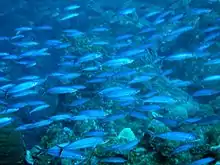Haemulon vittatum
Haemulon vittatum, the boga, is an ocean-going species of grunt native to the western Atlantic Ocean. Bogas are also known as the snit in Jamaica, and bonnetmouth in the Bahamas.[1] It was first described by Cuban zoologist Felipe Poey.
| Haemulon vittatum | |
|---|---|
 | |
| A shoal of boga off the coast of Cuba. | |
| Scientific classification | |
| Kingdom: | Animalia |
| Phylum: | Chordata |
| Class: | Actinopterygii |
| Order: | Perciformes |
| Family: | Haemulidae |
| Genus: | Haemulon |
| Species: | H. vittatum |
| Binomial name | |
| Haemulon vittatum (Poey, 1860) | |
| Synonyms | |
| |
Description
_at_cleaning_station.jpg.webp)
The boga is a spindle-shaped fish. It has a deeply forked caudal fin, and its two dorsal fins are close together. It is also able to protrude its mouth much further than many fishes,[2] hence the name bonnetmouth. They usually have 14-15 spines on their dorsal fins, but only 10 soft rays. They have two spines and 9 rays on their anal fins, as well.[3] The longest recorded Boga was 23 cm in length[4]
The boga's life colors are generally greenish above, and blueish-white below. A greenish stripe, tinged with yellow, can be seen from the eye to the tail. Three similar stripes are on the back. The snout and dorsal fins are both yellowish or pale yellow, while the caudal fin is dusky violet. The pectoral fins are both rosy, and the anal and ventral fins are both white.[5]
Distribution and habitat
The boga is only known from the western Atlantic Ocean from Florida and the Bahamas south to northern South America, including the Antilles and the Caribbean.[6]
Occurring in open water,[7] Bogas are sometimes found near coasts[7] or over reefs[8] they can mainly be found off of oceanic islands,[7] where they feed on zooplankton and smaller fishes.[3] Bogas are occasionally sold fresh, and used as baitfish;[3] they are known to be preyed upon by the red hind (Epinephelus guttatus), a member of the grouper family.[9]
References
- Froese, Rainer and Pauly, Daniel, eds. (2013). "Haemulon vittatum" in FishBase. August 2013 version.
- Randall, J.E. 1996 Caribbean reef fishes. Third edition - revised and enlarged. T.F.H. Publications, Inc. Ltd., Hong Kong. 3rd ed. 368 p.
- Froese, Rainer and Pauly, Daniel, eds. (2009). "Inermia vittata" in FishBase. 08 2009 version.
- Claro, R. 1994 Características generales de la ictiofauna. p. 55-70. In R. Claro (ed.) Ecología de los peces marinos de Cuba. Instituto de Oceanología Academia de Ciencias de Cuba and Centro de Investigaciones de Quintana Roo.
- Bohlke, James E. Charles C. G. Chaplin. Fishes of the Bahamas and Adjacent Tropical Waters. 2nd edition. Austin, UP of Texas. 305.
- Smith, C.L. 1997 National Audubon Society field guide to tropical marine fishes of the Caribbean, the Gulf of Mexico, Florida, the Bahamas, and Bermuda. Alfred A. Knopf, Inc., New York. 720 p.
- Lieske, E. and R. Myers 1994 Collins Pocket Guide. Coral reef fishes. Indo-Pacific & Caribbean including the Red Sea. Harper Collins Publishers, 400 p.
- Cervigón, F., R. Cipriani, W. Fischer, L. Garibaldi, M. Hendrickx, A.J. Lemus, R. Márquez, J.M. Poutiers, G. Robaina and B. Rodriguez 1992 Fichas FAO de identificación de especies para los fines de la pesca. Guía de campo de las especies comerciales marinas y de aquas salobres de la costa septentrional de Sur América. FAO, Rome. 513 p. Preparado con el financiamento de la Comisión de Comunidades Europeas y de NORAD.
- Randall, J.E. 1967 Food habits of reef fishes of the West Indies. Stud. Trop. Oceanogr. Miami 5: 665-847
External links
- Photos of Haemulon vittatum on Sealife Collection